Field Emission of Multi-Walled Carbon Nanotubes from Pt-Assisted Chemical Vapor Deposition
Abstract
:1. Introduction
2. Materials and Methods
3. Results
3.1. Structural Characterization of Carbon Nanotubes
3.2. Field Emission Performance Test
4. Conclusions
Supplementary Materials
Author Contributions
Funding
Data Availability Statement
Conflicts of Interest
References
- Dai, H.; Xiao, D.; He, H.; Li, H.; Yuan, D.; Zhang, C. Synthesis and analytical applications of molecularly imprinted polymers on the surface of carbon nanotubes: A review. Microchim. Acta 2015, 182, 893–908. [Google Scholar]
- Ren, X.; Chen, C.; Nagatsu, M.; Wang, X. Carbon nanotubes as adsorbents in environmental pollution management: A review. Chem.Eng. J. 2011, 170, 395–410. [Google Scholar] [CrossRef]
- Liu, X.-M.; Huang, Z.D.; Oh, S.W.; Zhang, B.; Ma, P.-C.; Yuen, M.M.; Kim, J.-K. Carbon nanotube (CNT)-based composites as electrode material for rechargeable Li-ion batteries: A review. Compos. Sci. Technol. 2012, 72, 121–144. [Google Scholar] [CrossRef]
- Niu, L.; Luo, Y.L.; Li, Z. A highly selective chenical gassensor based on functionalization of multi-walled carbon nanotubes with poly (ethylene glycol). Sens. Actuat. B-Chem. 2007, 126, 361–367. [Google Scholar] [CrossRef]
- Dong, C.; Gupta, M.C. Influences of the surface reactions on thefield emission from multiwall carbon nanotubes. Appl. Phys. Lett. 2003, 83, 159–161. [Google Scholar] [CrossRef]
- Dong, C.; Luo, H.; Cai, J.; Wang, F.; Zhao, Y.; Li, D. Hydrogen sensing characteristics from carbon nanotube field emissions. Nanoscale 2016, 8, 5599–5604. [Google Scholar] [CrossRef]
- Hadsell, M.; Zhang, J.; Laganis, P.; Sprenger, F.; Shan, J.; Zhang, L.; Burk, L.; Yuan, H.; Chang, S.; Lu, J.; et al. A first generation compact microbeam radiation therapy system based on carbon nanotube X-ray technology. Appl. Phys. Lett. 2013, 103, 183505. [Google Scholar] [CrossRef] [Green Version]
- Moisala, A.; Nasibulin, A.G.; Kauppinen, E.I. The role of metal nanoparticles in the catalytic production of single-walled carbon nanotubes—A review. J. Phy. Condens. Mat. 2003, 15, S3011–S3035. [Google Scholar] [CrossRef]
- Dupuis, A.C. The catalyst in the CCVD of carbon nanotubes—A review. Prog. Mater. Sci. 2005, 50, 929–961. [Google Scholar] [CrossRef]
- Bronikowski, M.J. CVD growth of carbon nanotube bundle arrays. Carbon 2006, 44, 2822–2832. [Google Scholar] [CrossRef]
- Terrado, E.; Redrado, M.; Mun, E.; Maser, W.K.; Benito, A.M.; Martínez, M.T. Carbon nanotube growth on cobalt-sprayed substrates by thermal CVD. Mater. Sci. Eng. C. 2006, 26, 1185–1188. [Google Scholar] [CrossRef]
- Zhang, J.; Li, D.; Zhao, Y.; Cheng, Y.; Dong, C. Wide-range Vacuum Measurements from MWNT Field Emitters Grown Directly on Stainless Steel Substrates. Nanoscale Res. Lett. 2016, 11, 2–7. [Google Scholar] [CrossRef] [Green Version]
- Li, D.; Wang, Y.; Cheng, Y.; Feng, Y.; Zhao, L.; Zhang, H.; Sun, J.; Dong, C. An overview of ionization gauges with carbon nanotube cathodes. J. Phys. D Appl. Phys. 2015, 48, 473001. [Google Scholar] [CrossRef]
- Lee, Y.Z.; Burk, L.; Wang, K.H.; Cao, G.; Lu, J.; Zhou, O. Carbon Nanotube based X-ray Sources: Applications in Pre-Clinical and Medical Imaging. Nucl. Instrum. Meth. A. 2011, 648, S281–S283. [Google Scholar] [CrossRef] [Green Version]
- He, M.; Vasala, S.; Jiang, H.; Karppinen, M.; Kauppinen, E.I.; Niemelä, M.; Lehtonen, J. Growth and surface engineering of verticallyaligned low-wall-number carbon nanotubes. Carbon 2012, 50, 4750–4764. [Google Scholar] [CrossRef]
- Bayer, B.C.; Fouquet, M.; Blume, R.; Wirth, C.T.; Weatherup, R.S.; Ogata, K.; Knop-Gericke, A.; Schlögl, R.; Hofmann, S.; Robertson, J. Co-catalytic solid-state reduction applied to carbon nanotube growth. J. Phys. Chem. C. 2012, 116, 1107–1113. [Google Scholar] [CrossRef]
- Zhang, Q.; Zhao, M.; Huang, J.; Nie, J.; Wei, F. Mass prouction of aligned carbon nanotube arrays byfluidized bed catalytic chemical vapor deposition. Carbon 2010, 48, 1196–1209. [Google Scholar]
- Kiang, C.-H.; Goddard, W.; Beyers, R.; Salem, J.R.; Bethune, D.S. Catalytic Synthesis of Single-Layer Carbon Nanotubes with a Wide Range of Diameters. J. Phys. Chem. 1994, 98, 6612–6618. [Google Scholar] [CrossRef]
- Teng, I.; Huang, C.; Hsu, H.; Chung, I.; Jian, S.; Kherani, N.P.; Kuo, C.; Juang, J. On the use of new oxidized Co-Cr-Pt-O catalystsfor vertically-aligned few-walled carbon nanotube forest synthesis in electron cyclotron resonance chemical vapor deposition. Carbon 2014, 80, 808–822. [Google Scholar] [CrossRef]
- Wang, Z.; Gao, R.; Heer, W.; Poncharal, P. In situ imaging of field emission from individual carbon nanotubes and their structural damage. Appl. Phys. Lett. 2002, 80, 856–858. [Google Scholar] [CrossRef] [Green Version]
- Saito, R.; Fujita, M.; Dresselhaus, G.; Dresselhaus, M.S. Electronic structure of chiral graphene tubules. Appl. Phys. Lett. 1992, 60, 2204–2206. [Google Scholar] [CrossRef]
- Guo, T.; Nikolaev, P.; Thess, A.; Colbert, D.T.; Smalley, R.E. Catalytic growth of single-walled manotubes by laser vaporization. Chem. Phys. Lett. 1995, 243, 49–54. [Google Scholar] [CrossRef]
- Sridhar, S.V.; Ge, L.; Tiwary, C.S.; Hart, A.C.; Ozden, S.; Kalaga, K.; Lei, S.; Sinha, R.; Harsh, H.; Kordas, K.; et al. Enhanced field emission properties from CNT arrays synthesized on inconel superalloy. ACS Appl. Mater. Inter. 2014, 6, 1986–1991. [Google Scholar] [CrossRef]
- Maruyama, T.; Mizutani, Y.; Naritsuka, S.; Iijima, S. Single-Walled Carbon Nanotube Growth in High Vacuum Using Pt Catalyst in Alcohol Gas Source Method. Mater. Express. 2011, 1, 267–272. [Google Scholar] [CrossRef]
- Kondo, H.; Fukuoka, N.; Ghosh, R.; Naritsuka, S.; Maruyama, T.; Iijima, S. Low-Temperature Single-Walled Carbon Nanotube Growth from Pt Catalyst Using Alcohol Gas Source Method in High Vacuum. Jpn. J. Appl. Phys 2013, 52, 06GD02. [Google Scholar] [CrossRef]
- Neupane, S.; Lastres, M.; Chiarella, M.; Li, W. Synthesis and field emission properties of vertically aligned carbon nanotube arrays on copper. Carbon 2012, 50, 641–2650. [Google Scholar] [CrossRef]
- Kimura, H.; Zhao, B.; Futaba1, D.N.; Yamada, T.; Kurachi, H.; Uemura, K.; Hata, K. Field emission from laterally aligned carbon nanotube flower arrays for low turn-on field emission. APL Mater. 2013, 1, 032101. [Google Scholar] [CrossRef] [Green Version]
- Chen, G.; Neupane, S.; Li, W.; Chen, L.; Zhang, J. An increase in the field emission from vertically aligned multi-walled carbon nanotubes caused by NH3 plasma treatment. Carbon 2013, 52, 468–475. [Google Scholar] [CrossRef]
- Li, C.; Zhang, Y.; Mann, M.; Hasko, D.; Lei, W.; Wang, B.; Chu, D.; Pribat, D.; Amaratunga, G.A.J.; Milne, W.I. High emission current density, vertically aligned carbon nanotube mesh, field emitter array. Appl. Phys. Lett. 2010, 97, 113107. [Google Scholar] [CrossRef]
- Fujii, S.; Honda, S.-I.; Machida, H.; Kawai, H.; Ishida, K.; Katayama, M.; Furuta, H.; Hirao, T.; Oura, K. Efficient field emission from an individual aligned carbon nanotube bundle enhanced by edge effect. Appl. Phys. Lett. 2007, 90, 153108. [Google Scholar] [CrossRef]
- Atthipalli, G.; Wang, H.; Gray, J.L. Catalyst-assisted vertical growth of carbon nanotubes on Inconel coated commercial copper foil substrates versus sputtered copper films. Appl. Surf. Sci. 2013, 273, 515–519. [Google Scholar] [CrossRef]
- Zhao, Y.; Cai, J.; Luo, H.; Kang, S.; Qian, W.; Dong, C. Low pressure hydrogen sensing based on carbon nanotube field emission: Mechanism of atomic adsorption induced work function effects. Carbon 2017, 124, 669–674. [Google Scholar] [CrossRef]
- Verma, P.; Gautam, S.; Kumar, P.; Chaturvedi, P.; Rawat, J.S.; Pal, S.; Chaubey, R.; Harsh; Vyas, H.P.; Bhatnagar, P.K. Carbon nanotube tip melting with vacuum breakdown in cold cathode. J. Vac. Sci. Technol. B 2007, 25, 1584–1587. [Google Scholar] [CrossRef]
- Srividya, S.; Gautam, S.; Jha, P.; Kumar, P.; Kumar, A.; Ojha, U.S.; Rawat, J.S.B.S.; Pal, S.; Chaudhary, P.K.; Harsh, R.; et al. Decoration of cesium iodide nano particles on patterned carbon nanotube emitter arrays to improve their field emission. Appl. Surf. Sci. 2013, 15, 1497. [Google Scholar]



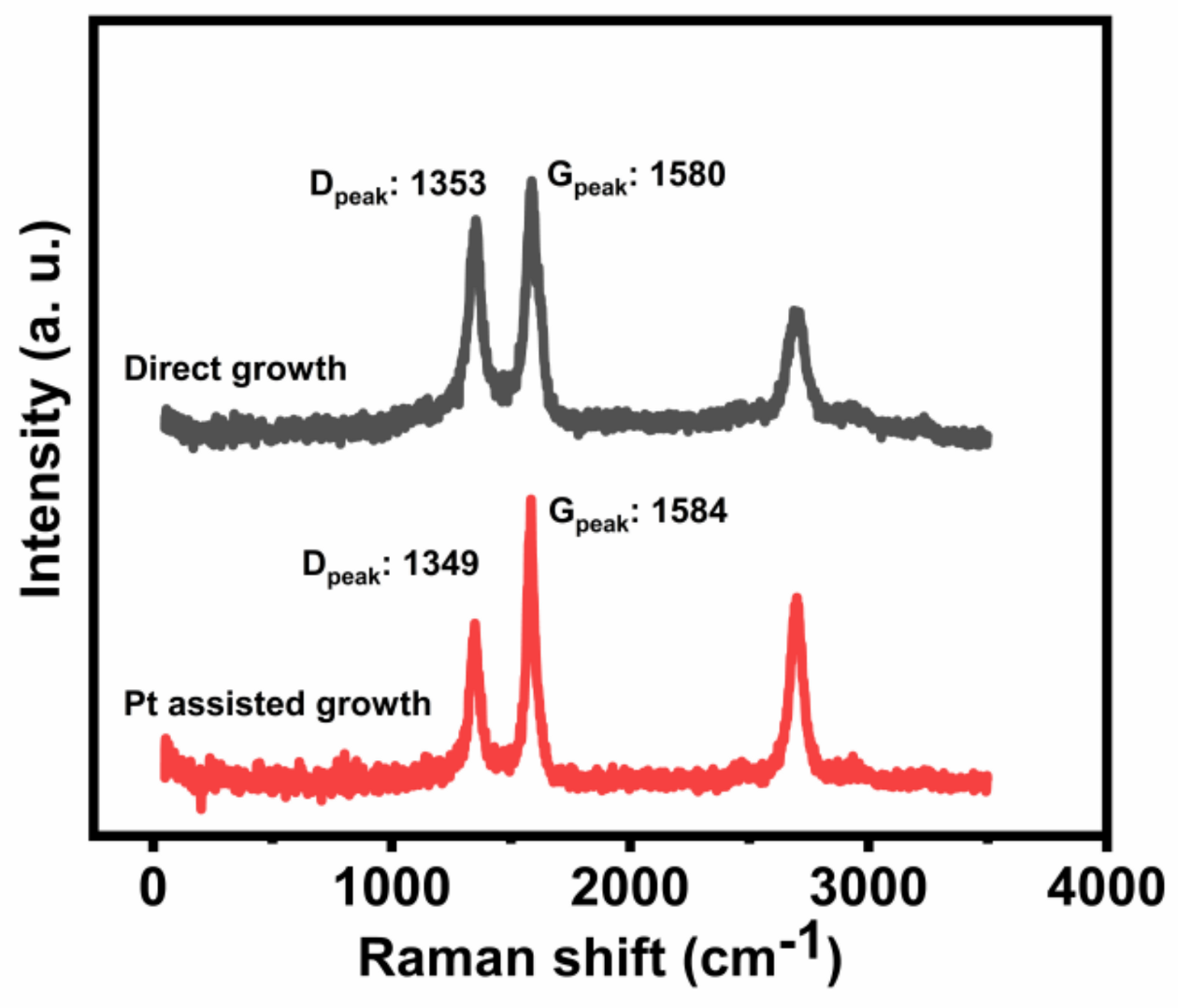
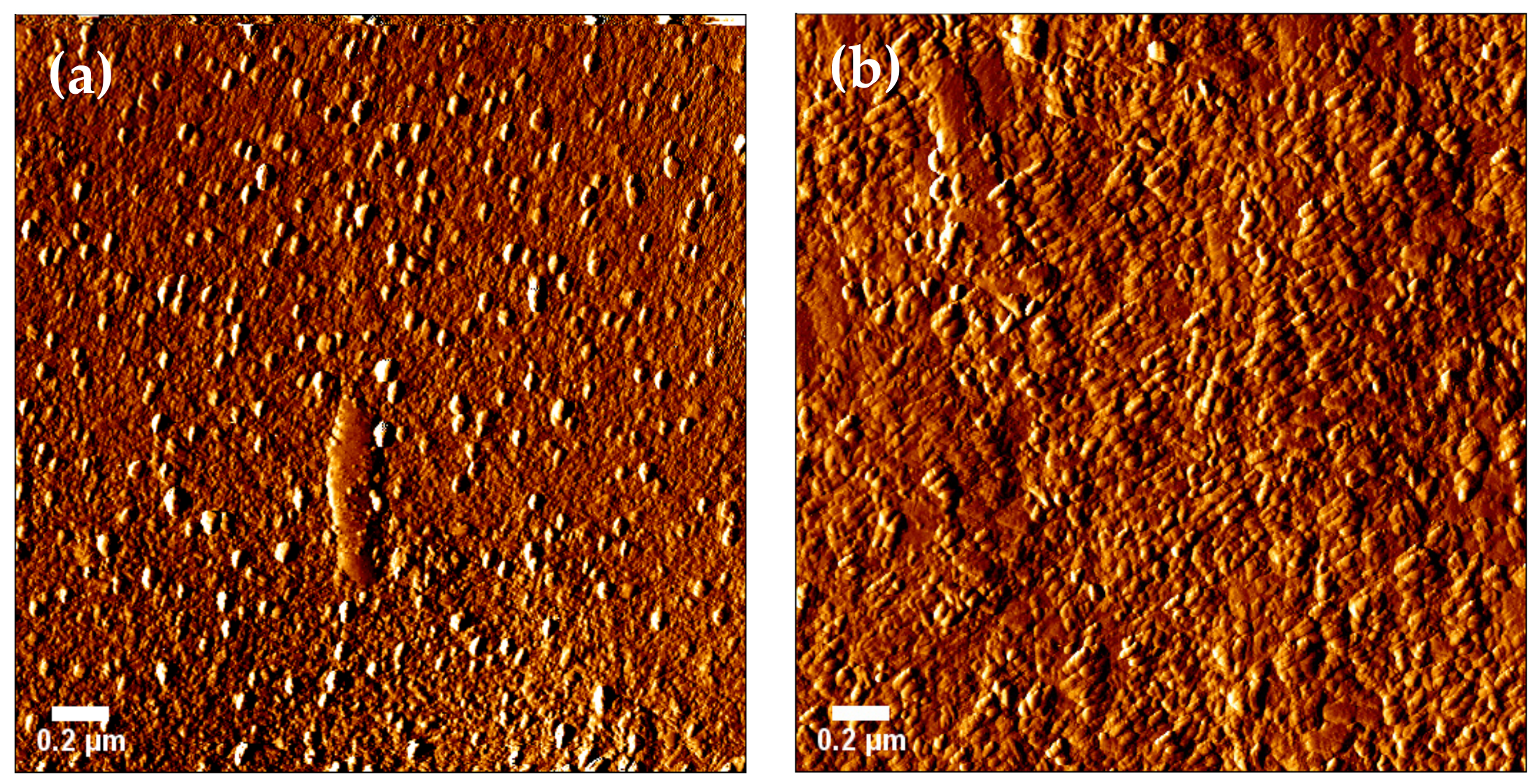
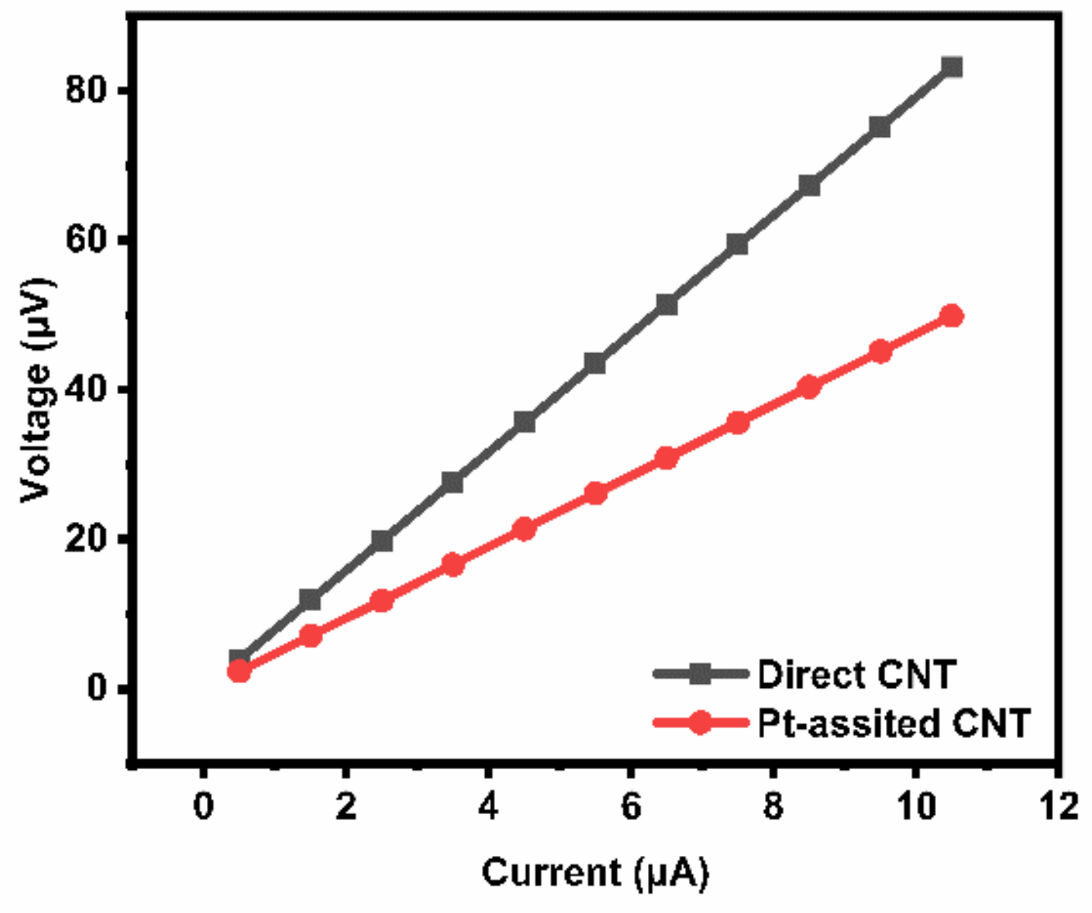
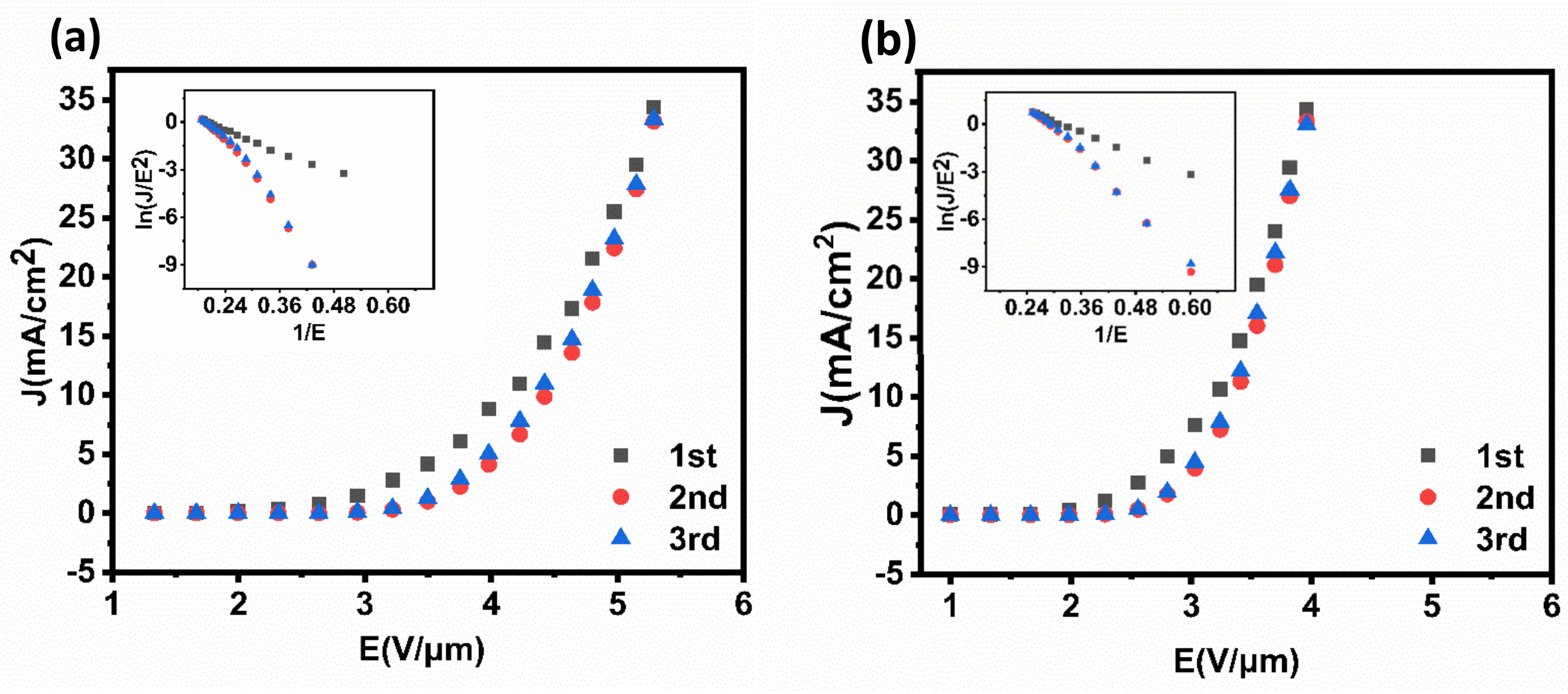
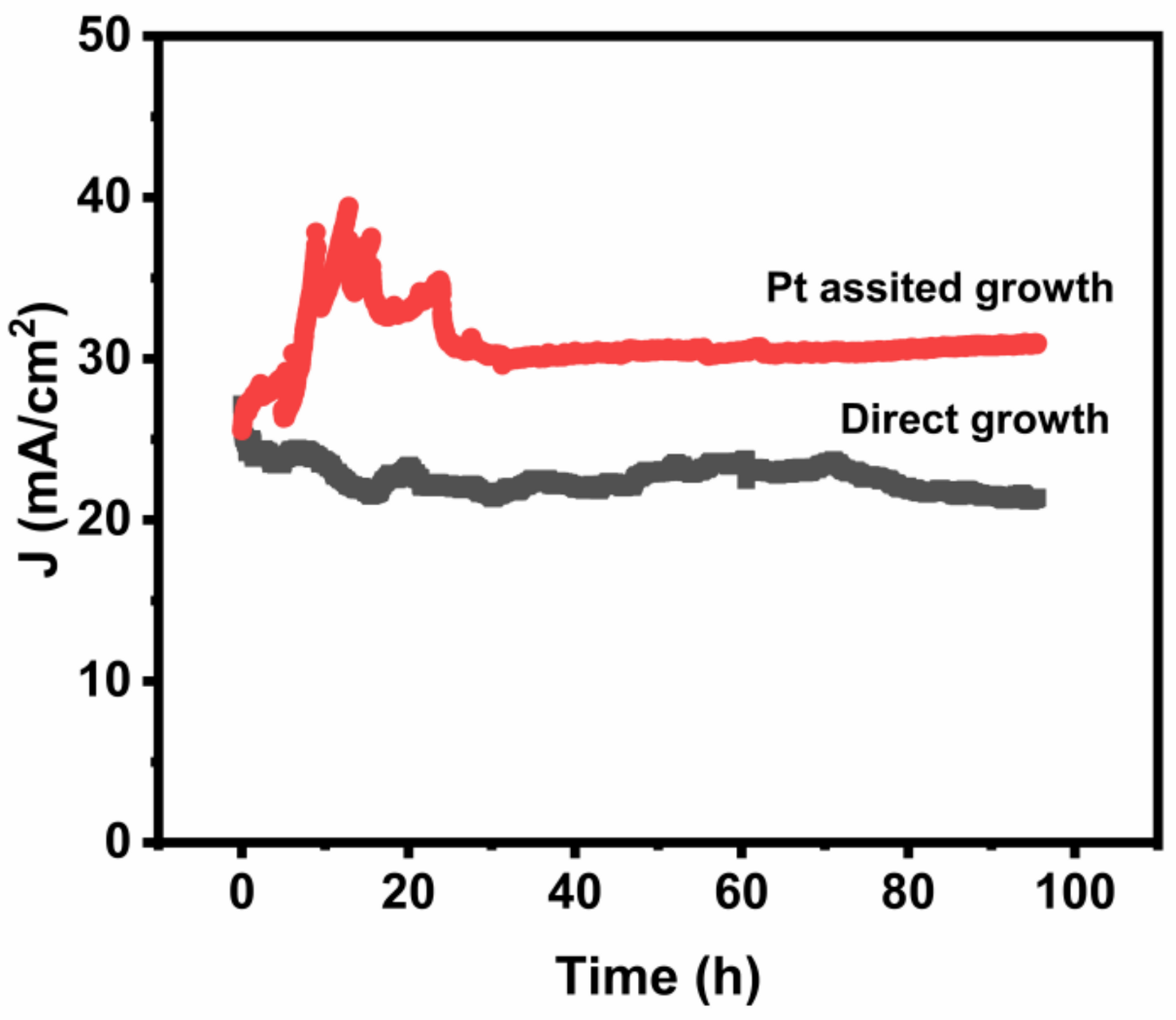
Publisher’s Note: MDPI stays neutral with regard to jurisdictional claims in published maps and institutional affiliations. |
© 2022 by the authors. Licensee MDPI, Basel, Switzerland. This article is an open access article distributed under the terms and conditions of the Creative Commons Attribution (CC BY) license (https://creativecommons.org/licenses/by/4.0/).
Share and Cite
Tang, H.; Liu, R.; Huang, W.; Zhu, W.; Qian, W.; Dong, C. Field Emission of Multi-Walled Carbon Nanotubes from Pt-Assisted Chemical Vapor Deposition. Nanomaterials 2022, 12, 575. https://doi.org/10.3390/nano12030575
Tang H, Liu R, Huang W, Zhu W, Qian W, Dong C. Field Emission of Multi-Walled Carbon Nanotubes from Pt-Assisted Chemical Vapor Deposition. Nanomaterials. 2022; 12(3):575. https://doi.org/10.3390/nano12030575
Chicago/Turabian StyleTang, Hongbin, Ruizi Liu, Weijun Huang, Wei Zhu, Weijin Qian, and Changkun Dong. 2022. "Field Emission of Multi-Walled Carbon Nanotubes from Pt-Assisted Chemical Vapor Deposition" Nanomaterials 12, no. 3: 575. https://doi.org/10.3390/nano12030575
APA StyleTang, H., Liu, R., Huang, W., Zhu, W., Qian, W., & Dong, C. (2022). Field Emission of Multi-Walled Carbon Nanotubes from Pt-Assisted Chemical Vapor Deposition. Nanomaterials, 12(3), 575. https://doi.org/10.3390/nano12030575




